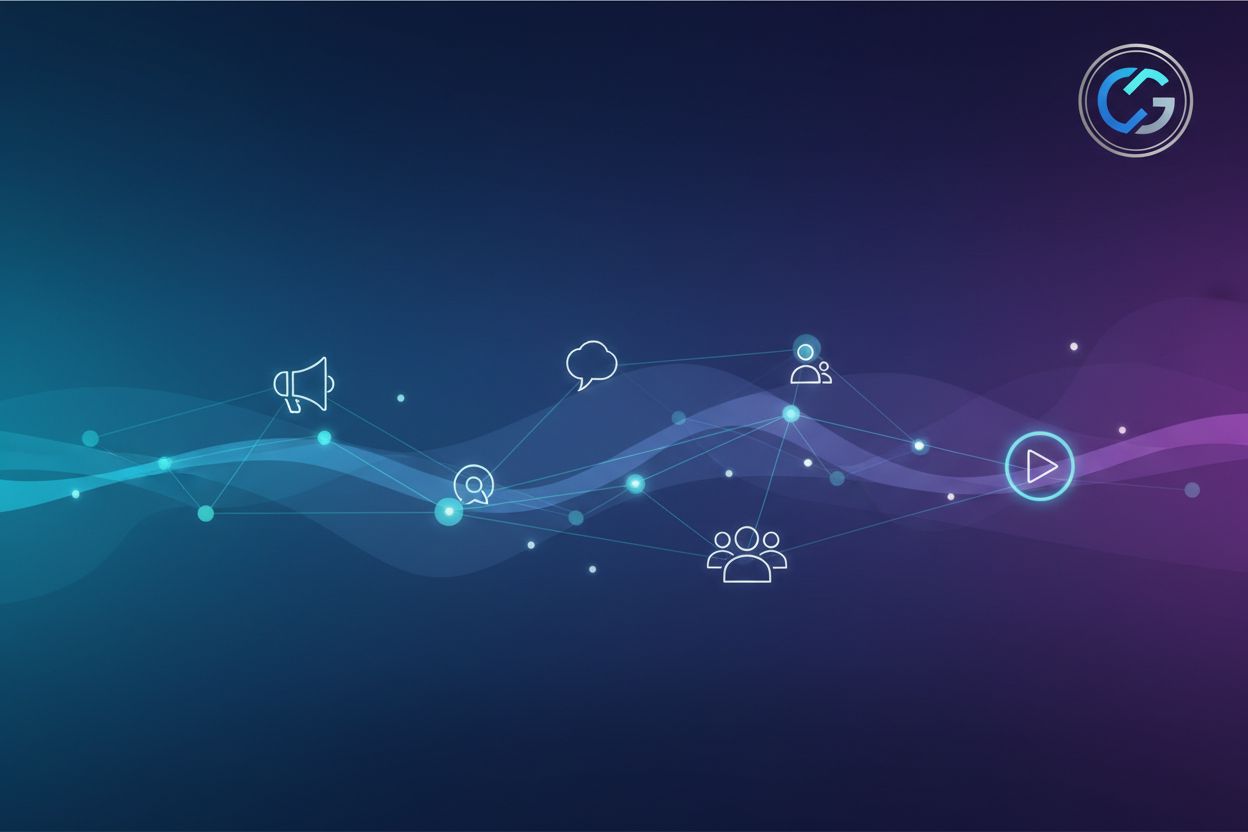Content Repurposing with AI: Maximize Your Content ROI
Introduction: The Power of Content Repurposing in the Age of AI
Content repurposing is no longer a luxury, but a necessity in today's fast-paced digital landscape. (Content Repurposing: Do More with Less) Are you maximizing the return on investment (ROI) from your content?
Many marketers face a constant struggle to keep up with the demand for fresh content across various platforms. (10 content marketing challenges and how to overcome them) Content teams often have limited time and resources. (Limits and specifications for Microsoft Teams) It can be difficult to maintain a consistent brand message, but ai can help address this.
- High demand for fresh, engaging content: Marketers need a steady stream of new content to attract and retain audiences on different channels.
- Limited time and resources for content creation: Many teams struggle to produce enough content with their existing staff and budgets.
- Difficulty maintaining consistent brand messaging and voice: It can be challenging to ensure that all content aligns with the brand's identity and values.
Content repurposing means adapting existing content into new formats and platforms. This approach can extend the lifespan of your content, reach new audiences, and save time and resources. Ai is now playing a key role in automating and streamlining this process.
- Definition: Content repurposing involves transforming existing content into different formats, such as turning a blog post into a video or social media snippets. According to Institute of AI Studies, ai tools can quickly adapt existing content for different platforms and audiences by, for example, identifying key themes or structuring narratives.
- Benefits: Repurposing extends the reach of content, saves time and resources, and helps reinforce your message across channels.
- The Role of Ai: Ai automates and streamlines the repurposing process, making it faster and more efficient.
The content marketing landscape is more competitive than ever. There is a growing need for efficiency and scalability in content production. Ai is a game-changer for content ROI. A Semrush 2023 State of Content Marketing report shows that 42% of marketers witnessed content marketing success by updating and repurposing existing content, often by reformatting it for different channels or updating it with new data.
- Increasing competition: Brands must stand out in a crowded content ecosystem.
- The need for efficiency and scalability: Companies need to produce more content with the same or fewer resources.
- Ai as a game-changer: Ai empowers marketers to repurpose content at scale, maximizing their ROI.
In the following sections, we'll explore how ai is revolutionizing content repurposing and how you can leverage it to maximize your content ROI.
Understanding Content Repurposing: Basics and Benefits
Did you know that repurposing content can increase your reach by up to 3x? Let's dive into the basics and benefits of this powerful strategy.
Content repurposing is the art of transforming existing content into new formats and platforms. Think of it as giving your content a second life. For instance, a blog post can become an infographic, or a webinar can be chopped into social media snippets.
At its core, content repurposing involves adapting existing material for different uses. Instead of creating everything from scratch, you leverage what you already have. This could mean turning a detailed guide into a series of short videos, or transforming a presentation into a blog series.
"Evergreen" content, which remains relevant over time, is particularly well-suited for repurposing. These timeless pieces can be adapted again and again, ensuring they continue to deliver value.
A well-executed repurposing strategy offers numerous advantages. By expanding your content across multiple channels, you significantly increase your reach and visibility.
- Improved SEO: Diverse content formats and backlinks boost your search engine rankings.
- Time and cost savings: Repurposing is faster and cheaper than creating original content.
- Reinforced brand messaging: Consistent messaging across platforms strengthens your brand identity.
- Higher ROI: Maximizing the value of your existing content assets leads to better returns.
Not all content is ideal for repurposing. Focus on pieces that have already proven their worth. Start by analyzing your content performance metrics, such as traffic, engagement, and conversions.
Prioritize high-performing and evergreen content that resonates with your audience. Also, consider the preferences of your audience on different platforms. A technical whitepaper, for example, might be better suited as an infographic on social media.
By understanding the basics and benefits of content repurposing, you can start maximizing your content ROI. Next, we'll explore how ai can revolutionize this process.
The AI Advantage: How AI Tools are Transforming Content Repurposing
Ai isn't just a futuristic concept; it's actively reshaping how content is repurposed, saving time and resources. Let's explore how ai tools are revolutionizing content repurposing.
Ai offers several powerful techniques to transform content:
- Summarization: Ai can condense long-form content, such as whitepapers or e-books, into shorter formats like social media posts or blog summaries. This enables quick consumption of key insights.
- Rewriting: Ai can adapt content for different tones and styles. A formal report can be rewritten into a casual blog post, or vice versa.
- Format Conversion: Ai can transform text into various formats. For instance, it can create video scripts from blog posts or generate infographics from data-heavy reports by identifying key themes and structuring narratives.
- Translation: Ai facilitates localizing content for global audiences. It can translate articles, social media posts, and other materials into multiple languages.
Several ai tools are making content repurposing easier and more efficient:
- Repurpose.io: This tool focuses on video repurposing across social media platforms. It helps extract key segments, add captions, and optimize for each platform.
- Revid: Revid provides ai-powered video editing and captioning. It allows users to quickly create different versions of their content with automated captions and text-to-speech features.
- Visme: Visme is a visual content creation tool that assists in data visualization. It helps transform text-based content into engaging graphics like infographics and presentations.
- Opus Clips: This tool uses ai to clip long videos into short, engaging social media content. It automatically identifies key moments and creates shareable clips.
- Typeface: Typeface provides ai templates that help repurpose anything, from documents to podcasts, into written content. These templates might offer pre-defined structures or prompts to guide the repurposing process.
Leveraging ai for content repurposing offers numerous benefits:
- Increased efficiency and speed: Ai significantly speeds up content production. Automating tasks like summarization and rewriting saves valuable time.
- Reduced manual effort and costs: By automating repetitive tasks, ai reduces the need for manual labor. This lowers overall content creation costs.
- Improved content quality and consistency: Ai helps maintain a consistent brand voice across different platforms. It ensures that repurposed content aligns with your brand guidelines.
- Enhanced personalization: Ai can tailor content for different audiences. By analyzing audience preferences, it ensures that repurposed content resonates with specific groups.
- Data-driven insights: Ai provides valuable insights for optimizing repurposing strategies. It helps identify which formats and platforms yield the best results.
Ai is transforming content repurposing, making it faster, more efficient, and more effective. Next, we'll look at how to identify content ripe for repurposing.
Practical Strategies: Repurposing Content Across Different Platforms
Repurposing content across different platforms is crucial for maximizing your content's reach and ROI. But how do you effectively adapt your existing content for various channels? Let's explore some practical strategies.
One powerful strategy is transforming blog posts into engaging social media content. Extract key quotes and statistics from your blog posts. This creates easily digestible snippets for platforms like Twitter and Facebook.
Create engaging visuals and infographics that highlight key takeaways. Visual content often performs better on platforms like Instagram and Pinterest. For example, a financial services company could turn a blog post about retirement planning into a series of Instagram carousels.
Turn blog posts into Twitter threads or LinkedIn articles. This allows you to share your expertise with a wider audience. Ai tools can help generate social media captions and hashtags, saving you time and effort.
Breaking down ebooks and whitepapers into a series of blog posts is another effective strategy. This allows you to make your long-form content more accessible to a broader audience. Summarize key findings and insights from your ebooks and whitepapers. This makes them easier for blog readers to consume.
Create lead magnets and content upgrades from your blog posts. This can help you generate leads and build your email list. Ai can rewrite and optimize content for SEO, improving your search engine rankings.
Transcribing video and audio content into blog posts or articles can significantly expand your reach. Not everyone has time to watch a full video or listen to a podcast, so providing a written transcript can be beneficial. Create show notes and summaries for podcasts. This allows you to provide value to your audience even if they don't have time to listen to the full episode.
Turn webinars and presentations into ebooks or guides. Offer this as a valuable resource to your audience. Ai can generate captions and subtitles for videos, making them more accessible to a wider audience.
By strategically repurposing content across different platforms, you can maximize your content's impact and ROI. Next, we'll discuss measuring the success of your content repurposing efforts.
Creative Repurposing Ideas: Thinking Outside the Box with AI
Stuck in a content rut? Ai can spark fresh ideas to repurpose your existing material in unexpected ways.
Instead of just sharing a link to your latest blog post, transform it into an engaging carousel on LinkedIn. To do this effectively:
- Summarize key points from a blog post into bite-sized insights. This makes it easy for your audience to digest the information.
- Use ai to generate engaging headlines for each slide. Compelling headlines capture attention and encourage viewers to swipe through the carousel.
- Carousels drive higher engagement than static posts. This format keeps your audience interested and encourages interaction.
For example, a healthcare company could turn a blog post about mental health into a carousel with tips for managing stress.
Webinars are packed with valuable content, but they can be time-consuming to watch. Ai can help you create a whole content series from one webinar.
- Upload webinar transcripts and use ai to break them into themed blog posts. This makes the content more accessible to a broader audience.
- Ai can help to structure the content logically and highlight key takeaways, which directly contributes to creating a blog series from a webinar.
- Create a whole content series from one webinar. This allows you to maximize the value of your webinar content and keep your audience engaged over time.
A financial services firm, for instance, could transform a webinar on retirement planning into a series of blog posts covering different aspects of retirement.
List-style blog posts are popular, but they can be even more engaging in video format.
- Take list-style blog posts and repurpose them into video scripts. This allows you to reach a wider audience on YouTube.
- Ai can write natural-sounding intros and transitions. This ensures that your video flows smoothly and keeps viewers engaged.
- YouTube favors educational, structured content. Turning listicles into videos is a quick win for your YouTube channel.
For example, a retail company could turn a listicle about "10 Fashion Trends for Fall" into a visually appealing YouTube video.
By thinking creatively and leveraging ai, you can unlock the full potential of your content. Next, we'll explore how to measure the success of your content repurposing efforts.
Best Practices for Effective AI Content Repurposing
Are you ready to take your content repurposing to the next level? By following a few key best practices, you can ensure your ai-powered efforts are effective and aligned with your goals.
Start by aligning your repurposing efforts with your overall marketing goals. This ensures that your content serves a purpose and contributes to your broader business objectives.
- Set SMART goals: Specific, Measurable, Achievable, Relevant, and Time-bound. For instance, a healthcare company might aim to increase website traffic by 20% in three months by repurposing existing blog posts into social media content.
- Identify your target audiences and tailor your content accordingly. A financial services firm may create different versions of a retirement planning guide for young professionals versus older adults. Ai can assist in this tailoring by adjusting language, tone, or focus.
It's crucial to maintain a consistent brand image across all platforms, even when using ai.
- Ensure that repurposed content aligns with your brand guidelines. This includes visual elements, tone, and messaging.
- Use ai to adapt content while preserving your brand voice. Before publishing, always review and edit ai-generated content to ensure brand accuracy.
- Leverage the power of ai with Publish7 to create expert content marketing, SEO and Link Building strategies for Free.
- Drive traffic, enhance visibility, and grow your brand effortlessly. Publish7 also provides UX review to improve content engagement across platforms.
Each platform has its own unique requirements and audience preferences.
- Adapt content formats and styles to platform-specific requirements. What works on LinkedIn may not work on TikTok, and vice versa.
- Use appropriate visuals, hashtags, and calls-to-action for each platform. A retail company might use eye-catching images and relevant hashtags on Instagram, while a B2B firm may focus on professional content and industry-specific groups on LinkedIn.
By setting clear goals, maintaining brand consistency, and optimizing for different platforms, you can maximize the impact of your ai content repurposing efforts. Next, we'll explore how to measure the success of your content repurposing efforts.
Measuring Success: Tracking and Analyzing Repurposing Performance
Are you getting the most out of your content repurposing efforts? Measuring performance is key to understanding what resonates with your audience and optimizing your strategy.
To determine the return on investment (ROI) of your content repurposing efforts, focus on these key metrics:
- Website traffic and engagement: Monitor page views, time on page, and bounce rate to see how repurposed content drives traffic to your site and keeps visitors engaged. For example, a series of blog posts repurposed from a webinar should increase traffic to the webinar landing page, as the blog posts act as teasers or offer additional value that drives users to the original source.
- Social media reach and engagement: Track likes, shares, and comments to measure how well your repurposed content resonates with your social media audience. A healthcare company repurposing a blog post into an Instagram carousel should see increased engagement.
- Lead generation and conversion rates: Analyze how repurposed content contributes to lead generation and conversions. A financial services firm repurposing a whitepaper into a series of emails should track the number of leads generated from the email campaign.
- SEO rankings and organic traffic: Monitor keyword rankings and organic traffic to assess the impact of repurposed content on your search engine visibility. Repurposing content with updated keywords can improve SEO performance.
- Backlink acquisition and domain authority: Track the number of backlinks acquired through repurposed content and its impact on your domain authority. High-quality backlinks improve search engine rankings.
Use these tools and techniques to effectively track the performance of your repurposed content:
- Google Analytics: Leverage Google Analytics to monitor website traffic, user behavior, and conversion rates. This helps you understand how repurposed content drives traffic and engagement on your site.
- Social media analytics dashboards: Utilize social media analytics dashboards to track engagement metrics such as likes, shares, and comments. These dashboards provide insights into how your repurposed content performs on different social platforms.
- SEO tools (Ahrefs, SEMrush): Use SEO tools like Ahrefs or SEMrush to monitor keyword rankings, backlinks, and organic traffic. These tools help you assess the impact of repurposed content on your search engine optimization efforts.
- CRM systems: Integrate your content repurposing efforts with your CRM system to track lead generation and conversion data. This allows you to measure the direct impact of repurposed content on your sales pipeline.
Continuous improvement is essential for maximizing the ROI of your content repurposing efforts. Here’s how to iterate and improve:
- Analyze performance data: Use the data you’ve collected to identify areas for improvement. Which formats and platforms are performing best? Where are you seeing the most engagement?
- Experiment with different content formats and platforms: Try repurposing content in new and creative ways. Test different formats and platforms to see what resonates with your audience.
- Refine AI prompts and workflows: If you’re using ai tools, experiment with different prompts and workflows to achieve better results. For example, try prompts like "Summarize this article into three bullet points for Twitter" or "Rewrite this blog post in a more casual tone for a LinkedIn audience."
- Stay updated with the latest AI tools and techniques: The field of ai is constantly evolving. Stay informed about the latest tools and techniques to ensure you’re leveraging the most effective methods for content repurposing.
By diligently tracking and analyzing the performance of your repurposed content, you can refine your strategy and maximize your content ROI.
Conclusion: Embracing AI for a More Efficient and Effective Content Strategy
Ai-powered content repurposing is rapidly evolving, promising even greater efficiency and effectiveness. What does the future hold for this transformative approach?
Expect continued advancements in ai technology. Ai will become even more adept at understanding content nuances and generating high-quality variations. As ai models improve, content creators can look forward to even more sophisticated tools for repurposing content, such as better context understanding or more nuanced tone control.
Look for increased automation and personalization. Ai will automate more of the repurposing process, tailoring content to individual audience segments. This will help organizations deliver highly relevant content that resonates with specific groups.
Anticipate a growing emphasis on data-driven insights. Ai will provide deeper insights into content performance, enabling marketers to optimize their strategies and maximize ROI. For instance, ai can analyze which formats and platforms yield the best results for different types of content by correlating content attributes with engagement metrics across platforms.
Realize that content repurposing is now a strategic necessity. In today's competitive digital landscape, marketers need to maximize the value of their content assets. Content repurposing allows organizations to stay visible, remain top-of-mind, and leverage existing investments.
Understand that ai tools significantly enhance the efficiency of repurposing. Ai automates tasks like summarization, rewriting, and format conversion, saving time and resources. As mentioned earlier, ai can help organizations maintain a consistent brand voice across different platforms.
Take action and experiment with ai-powered repurposing techniques. Start by identifying high-performing content and explore how ai can help you adapt it for different channels. For example, turn a blog post into a series of social media snippets or an infographic.
Embracing ai for content repurposing is no longer optional; it's essential for staying competitive and maximizing content ROI. By integrating ai into your content strategy, you can unlock new levels of efficiency, personalization, and impact.





